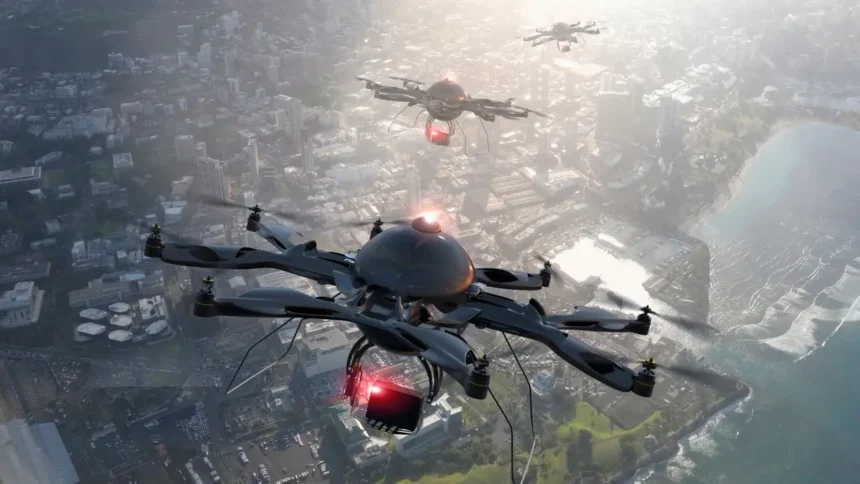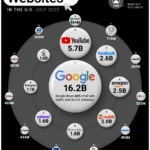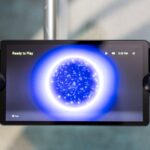In the rapidly expanding universe of drone technology, we have been conditioned to believe that sight is everything. We marvel at high-resolution cameras, sophisticated LiDAR scanners, and thermal imaging that can spot a human from a thousand feet. But what happens when the light goes out?
What happens when a drone, a multi-thousand-dollar piece of advanced technology, is faced with the very environments where it is needed most: a smoke-filled building, a dust-choked mine, or a collapsed structure in total darkness?
The answer, until now, has been simple: It fails.
This single point of failure has created a massive, high-value blind spot in the drone industry. The most critical, dangerous, and lucrative tasks, such as internal industrial inspections and front-line disaster response, have remained agonizingly out of reach.
But that is about to change.
A brilliant team of US researchers has developed a new class of tiny, autonomous drones that navigate not with eyes, but with ears. Inspired by bats, these micro-UAVs use sound and advanced artificial intelligence to fly with precision in an absolute blackout.
This breakthrough, known as the PeAR Bat, is not just a clever academic project. It is a disruptive enabler, a key that is about to unlock a multi-billion dollar frontier for autonomous systems. It has profound implications for industrial asset management, structural integrity assessment, insurance technology, and defense logistics.
The “Blind Spot” in the Trillion-Dollar Drone Industry
To understand why this development is so significant, we must first appreciate the fundamental limitations of our current technology stack. The entire autonomous navigation industry is built on two pillars: GPS (Global Positioning System) and visual sensors. Both are remarkably effective, and both are critically flawed.
The Failure of GPS and LiDAR
GPS is a modern marvel, but its signal is fragile. It cannot penetrate buildings, rock, or even dense urban canopies. Any mission that requires a drone to fly inside a structure, underground, or in a tight “urban canyon” immediately becomes a “GPS-denied environment.”
To solve this, the industry turned to visual sensors, primarily LiDAR (Light Detection and Ranging) and standard optical cameras. The idea was to create a “visual odometry” system where the drone “sees” its surroundings and maps its own position relative to them. This is the same logic that powers many autonomous vehicle platforms.
But this, too, has a fatal flaw. These systems are based on light.
- Cameras Fail: In low light, they become noisy and unreliable. In total darkness, they are useless. In smoke, fog, or heavy dust, they are instantly blinded.
- LiDAR Fails: LiDAR, which uses laser pulses, is more robust. However, it is notoriously expensive and heavy. More importantly, it has a well-known vulnerability: transparent and reflective surfaces. A LiDAR-equipped drone will fly directly into a clean glass wall, a common obstacle in modern construction and office buildings, because the laser pulses pass right through it.
The High-Value Markets Left Behind
This “sight-based” limitation means the drone revolution has been locked out of its most valuable potential applications:
- Industrial Inspection: The oil and gas, energy, and manufacturing sectors spend billions annually on structural integrity assessment. This often requires inspecting the inside of dark, hazardous, and confined spaces like boilers, pressure vessels, pipelines, and mine shafts. Currently, this requires a complete shutdown of operations and sending in human inspectors, a process that is slow, expensive, and incredibly dangerous.
- Search and Rescue (SAR): In the critical “golden hour” after a building collapse, earthquake, or fire, first responders need to know what is inside. But the environment is the perfect storm of drone failures: dark, dusty, and full of smoke.
- Insurance and Asset Management: After a fire, flood, or structural failure, insurance risk assessors and damage assessment teams need to quantify the damage. They are often unable to enter the unstable, dark, or hazardous structure, forcing them to make estimates from the outside.
For all these sectors, the problem is the same. The technology fails precisely when and where it is needed most.
A New Class of Autonomous Systems: The PeAR Bat Changes the Game
This is the problem that Dr. Nitin J. Sanket and his team at the Perception and Autonomous Robotics Group (PeAR) at Worcester Polytechnic Institute (WPI) set out to solve. Their solution was to look not at autonomous cars, but at one of nature’s most perfect navigators: the bat.
Bats fly with unmatched agility in total darkness. They do not use sight; they use echolocation. They emit a high-frequency ultrasonic pulse and listen for the faint, returning echoes. By processing the time delay and subtle changes in these echoes, they build a rich, three-dimensional map of their world in real-time.
The WPI team set out to replicate this ability in a palm-sized micro-drone. The result is the PeAR Bat.
Solving the “Unsolvable” Problem: Hearing a Whisper in a Storm
Building a drone that makes sound is easy. Building a drone that listens is incredibly difficult.
The primary challenge, which has stumped researchers for years, is the drone’s own noise. The tiny, high-speed propellers create a massive amount of acoustic interference, often at the same ultrasonic frequencies the sensors need to listen for.
As Dr. Sanket describes it, it is like trying to hear a friend whisper while someone is shouting directly into your ear. The returning echo (the whisper) is thousands of times weaker than the propeller noise (the shout).
The WPI team’s breakthrough came from a brilliant, dual-pronged solution that combines hardware innovation with a powerful new AI software stack.
- Hardware Innovation: The team experimented with acoustic isolation materials and metamaterials. These are engineered to insulate the tiny, highly sensitive microphones from the drone’s own vibrations and propeller wash.
- The AI Software “Secret Sauce”: This is the true genius of the system. The team developed a physics-informed deep learning model. This is a cutting-edge branch of artificial intelligence. Instead of just being fed data, the AI is also taught the underlying physics of sound, echoes, and fluid dynamics.
This AI algorithm runs on the drone’s onboard computer. It learns the exact sound profile of the drone’s own propellers and creates a perfect “noise-canceling” filter. It actively subtracts the drone’s own noise from the microphone feed, isolating the faint, almost imperceptible echoes bouncing off obstacles.
This AI doesn’t just filter noise; it interprets the data. It processes the returning echoes to understand not just that an object is there, but its shape, distance, and even texture, allowing the drone to navigate complex, cluttered environments in a complete blackout.
Why Sound is the New Sight: Key Advantages of Acoustic Navigation
The PeAR Bat platform is not just an alternative to LiDAR; in many key areas, it is demonstrably superior. Its advantages create an entirely new value proposition for autonomous systems.
1. It Sees the “Invisible” (to LiDAR)
The most striking demonstration of the PeAR Bat’s capability is the “Plexiglass test.” In test flights, the team placed a clear plexiglass wall in the drone’s path.
A conventional, high-end drone equipped with LiDAR and optical cameras flies straight into the barrier and crashes. Its sensors fail to see it.
The PeAR Bat, using only sound, identifies the solid, sound-reflecting surface, stops, and navigates around it.
This single advantage is a game-changer for construction management and industrial inspection. Modern offices, data centers, and manufacturing plants are full of glass partitions, clear panels, and other transparent obstacles that are invisible to light-based navigation.
2. All-Weather, All-Light, All-Condition Operation
This is the primary selling point. The PeAR Bat’s “vision” is based on sound waves, which are unaffected by the limitations of light.
- Total Darkness: No problem.
- Thick Smoke: Sound waves travel through it.
- Heavy Dust & Fog: No impact on navigation.
This unlocks all the environments previously designated as “no-go” zones for drones.
3. Extreme Energy Efficiency
This is a critical, and often overlooked, business metric. LiDAR systems and the high-powered processors needed for visual odometry are incredibly power-hungry. They are a massive drain on a drone’s battery, leading to short flight times of 15-20 minutes.
The WPI team, by contrast, built the PeAR Bat using sensors that are shockingly simple. The ultrasonic sensors it uses are the exact same off-the-shelf components found in automatic faucets and car parking sensors.
According to the team’s research, these sensors consume 1,000 times less power than a standard micro-USB camera. This translates directly to:
- Longer Flight Times: More inspection area covered per charge.
- Smaller, Lighter Drones: The power system is the heaviest part of a drone. Less power means a smaller battery, a lighter drone, and improved safety.
4. Scalable, Low-Cost Technology
Because the PeAR Bat is built from inexpensive, readily available components, it is radically cheaper than its high-tech counterparts. The team estimates the current manufacturing cost at around $300 per drone.
If commercialized and produced at scale, that cost could drop to as low as $50 per unit.
Think about that. This is not a $50,000 specialist drone. This is a $50 disposable, autonomous asset.
This low cost shifts the entire business paradigm. Instead of deploying one expensive asset, a company can deploy a swarm of one hundred. They become an expendable tool, fundamentally changing the risk calculation for sending robotics into hazardous environments.
Unlocking High-Value Markets: The Commercial Applications
The development of a cheap, all-terrain, autonomous micro-drone is a catalyst. It creates new business models and solves expensive old problems for some of the world’s largest industries.
1. Search and Rescue (SAR) & Disaster Response
The Problem: After an earthquake or explosion, structures are unstable, dark, and filled with dust. First responders cannot enter, and thermal-camera drones cannot see through the smoke or penetrate the building.
The Acoustic Drone Solution: A SAR team arrives and deploys a swarm of 50 PeAR Bats. These $50 drones fly into the structure, autonomously spreading out to map the voids and debris piles. They can navigate through smoke-filled hallways and collapsed floors. Even if 40 of them are crushed or lost, the 10 that return provide a complete 3D map of the interior, perhaps using sensor fusion to carry a tiny thermal sensor to locate survivors. This is a capability that simply does not exist today.
High-Value Keywords: Search and Rescue Technology, Disaster Response Logistics, Emergency Services Technology, Autonomous SAR, First Responder Tech.
2. Industrial Inspection & Asset Management
The Problem: A major power generation company needs to inspect the inside of a massive boiler for its annual structural integrity assessment. This currently requires a 7-day cold shutdown, costing millions in lost revenue, and building expensive scaffolding to send a team of human inspectors into a dark, dangerous, confined space.
The Acoustic Drone Solution: An autonomous drone services provider is contracted. During a scheduled 8-hour overnight maintenance window, a technician launches a PeAR Bat. The drone flies an autonomous, pre-programmed path inside the boiler, using its echolocation to map the interior walls, welds, and pipes in total darkness. It returns with a complete 3D map and acoustic data that identifies potential cracks or weaknesses. The inspection is done in a fraction of the time, for a fraction of the cost, with zero human risk.
High-Value Keywords: Structural Integrity Assessment, Non-Destructive Testing (NDT), Preventive Maintenance Solutions, Industrial Inspection Services, Oil and Gas Inspection, Energy Sector Automation, Asset Lifecycle Management, Confined Space Inspection.
3. Insurance & Risk Assessment
The Problem: A four-story commercial warehouse, a major asset for a commercial property insurance firm, has suffered a massive fire. The structure is still standing but is filled with smoke, has no power, and is too dangerous for a human damage assessor to enter. The insurance company must write off the asset or make a massive payout based on an external-only estimate.
The Acoustic Drone Solution: An Insurtech (insurance technology) firm specializing in risk assessment is called in. They deploy an acoustic-navigating drone. The drone enters through a broken window and performs a 20-minute autonomous flight, navigating the smoke-filled, dark interior. It returns with a detailed map of the internal damage, showing which sections are a total loss and which are salvageable. This accurate, data-driven assessment saves the insurance firm millions in overpayment and provides a clear path for claims processing.
High-Value Keywords: Insurance Technology (Insurtech), Damage Assessment Services, Risk Management Solutions, Commercial Property Insurance, Insurance Claims Processing, Actuarial Science.
4. Defense and Security
The Problem: Military and law enforcement teams need to clear a subterranean tunnel complex or a dense urban structure in a GPS-denied environment. They have no way of knowing what is around the next corner, and sending in a soldier or a light-based robot is high-risk.
The Acoustic Drone Solution: A single, lightweight acoustic drone is deployed. It flies ahead of the team, autonomously navigating the dark corridors. It “hears” the layout of the rooms, identifies obstacles, and perhaps even uses its highly sensitive microphones to listen for movement. It provides critical Intelligence, Surveillance, and Reconnaissance (ISR) data, enhancing operator safety and mission success.
High-Value Keywords: Defense Technology, Autonomous Defense Systems, Military Robotics, Intelligence Surveillance Reconnaissance (ISR), GPS-Denied Navigation.
The Broader Tech Revolution: Beyond Just One Drone
The WPI “Bat Drone” is not an isolated miracle. It is a powerful signal of a much broader shift in autonomous navigation, a move away from total reliance on “perfect” data (like GPS) and toward a future of resilient, multi-modal sensor fusion.
The Rise of AI-Driven Navigation

The “secret sauce” of this drone, and many others like it, is the AI and machine learning software stack. The hardware is cheap; the intelligence is what creates the value.
We are seeing this trend across the industry. For example, the Red Cat ‘Black Widow’ drone, being tested by the US Army, is also a GPS-denied navigator. But instead of sound, it uses a solution from Palantir called VNav (Visual Navigation). This system uses AI to analyze a standard camera feed, identifying features in the landscape to navigate without GPS.
These two technologies, acoustic navigation and VNav, are not competitors. They are complements.
- VNav solves the “GPS-denied, light-available” problem (e.g., outdoor urban canyons).
- AcousticNav solves the “GPS-denied, no-light” problem (e.g., inside a smoky building).
The true holy grail, which this research accelerates, is sensor fusion: a single drone that uses all of them. A future autonomous system will navigate by GPS when available, switch to VNav if GPS is lost, and then switch to AcousticNav when it enters a dark or smoky building. The AI acts as the central “brain,” fusing data from all sensors to maintain a perfect state of awareness.
The Critical Role of Edge Computing
All this complex AI processing—filtering propeller noise, interpreting echoes, running deep learning models—cannot happen on a server in the cloud. The latency would be far too great; the drone would crash before it received a command.
This entire process must happen on the drone itself in real-time. This is the definition of Edge Computing.
The PeAR Bat is a powerful case study for the need for hyper-efficient, low-power, and powerful edge AI processors. As these autonomous systems become more common, the demand for this specialized hardware will skyrocket, creating yet another high-growth technology vertical.
The Future of Autonomous Systems: 2026 and Beyond
The work at Worcester Polytechnic Institute is a major step toward the true democratization of autonomous robotics. For decades, “autonomy” has been associated with million-dollar military projects and $100,000 autonomous vehicle prototypes.
The PeAR Bat proves that robust, life-saving autonomy can be achieved in a $50 package.
This accelerates several key trends we expect to see dominate through 2026:
- The Rise of Disposable Swarms: We will move from deploying one “exquisite” robot to deploying hundreds of “good enough” robots. Swarm intelligence, powered by AI, will allow these groups of drones to coordinate, map, and solve complex problems.
- Automation of High-Risk Labor: This technology will directly automate some of the world’s most dangerous jobs. This is not about replacing labor; it is about augmenting human capability and removing people from harm’s way. Human inspectors and first responders will become robot operators.
- Solving the BVLOS Hurdle: Regulators are hesitant to allow widespread BVLOS (Beyond Visual Line of Sight) drone operations because of the risk of collision. An acoustic “hear and avoid” system that works in all weather and can see glass is a giant leap forward in creating the “see and avoid” safety case that regulators demand.
For years, we have been promised a future of autonomous robots. We were told to watch the skies. It turns out, we should have been listening.
By combining millions of years of natural evolution with the latest in artificial intelligence, the PeAR Bat and its underlying technology have given drones a new sense. In doing so, they have opened our eyes to a new world of possibility.








